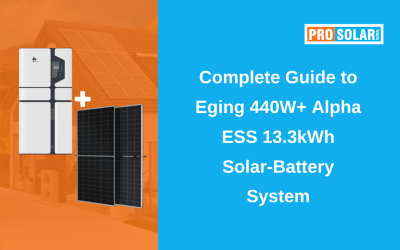In 2025, Sungrow offers two leading high-voltage modular battery systems: SBR and SBH. Each is designed for different applications—from typical homes to energy-intensive businesses. At Prosolar Global, we’ll guide you through their differences so you can choose the right system for your needs.
1. At a Glance: SBR vs SBH
Both systems use Lithium Iron Phosphate (LFP) chemistry, offering excellent safety, long life, and modular expandability.
| Feature | Sungrow SBR | Sungrow SBH |
| Module Capacity | 3.2 kWh per module | 5.0 kWh per module |
| Total Usable Capacity | 6.4 kWh to 25.6 kWh (2–8 modules) | 20 kWh to 40 kWh per unit (4–8 modules) |
| Charge/Discharge Current | ~30 A | Up to 50 A continuous |
| Best For | Residential homes with moderate demand | Large homes or light commercial sites |
| Inverter Compatibility | SH-RS and SH-RT/SHT series | Only SH-T hybrid inverters |
| Scalability | Standalone stack | Stackable up to 4 units (up to 160 kWh) |
| Depth of Discharge (DoD) | 100% usable capacity | 100% DoD |
| Warranty | 10 years or ~6,000 cycles | 10-year Australian-backed warranty |
| Inverter Ecosystem | Older ecosystem, less cross-stack | Adds flexibility and higher amperage |
2. Capacity & Scalability
- SBR modules can be configured from 6.4 kWh to 25.6 kWh, ideal for typical residential systems with gradual expansion in mind.
- SBH starts at 20 kWh, scaling to 40 kWh per unit, and supports up to 160 kWh by paralleling up to four units—well suited to commercial sites or energy‑heavy homes.
3. Power and Performance
- SBH delivers higher charge/discharge current—up to 50 A, compared to SBR’s ~30 A. This gives SBH an edge when writing to high-load demand like air conditioners, pool pumps or EV chargers.
- SBR is simpler and works well for normal household load profiles, with moderate charging needs.
4. Inverter Compatibility & Ecosystem
- SBR works with SH-RS (single‑phase) and SH‑RT/SHT (three‑phase) hybrid inverters. However, newer SBH systems require SH‑T inverters, offering higher-current support and more modern designs.
- SBR users may find their system locked into an older battery ecosystem if they later upgrade—SBH is more forward-compatible with Sungrow’s latest inverter range.
5. Real‑World Use Case Examples
- SBR is ideal if you’re a homeowner starting with ~6–10 kWh storage and perhaps adding more later. Its manageable size and compatibility suit most domestic solar systems.
- SBH is perfect if you have a larger household or minor commercial needs. Examples include a 24 × 5 kWh SBH installation delivering 120 kWh usable storage for a small business—reducing grid reliance and powering overnight demand effectively.
6. Installation & Expandability
- Both series feature plug-and-play modular design, with no internal cabling between modules, simplifying installation and upgrades.
- SBH supports stacking of units—connecting towers via Y‑connectors—providing flexible sizing for growing energy needs.
7. Safety, Warranty & Local Relevance
- Both models use safe LFP chemistry, which grants thermal stability and long cycle life.
- Sungrow offers a 10‑year warranty for both SBR and SBH, with supported cycle counts (~6,000 cycles or more in real Australian conditions).
8. Community Insights
As shared by users on Whirlpool forums:
“30 A charge/discharge on the SBR vs 50 A charge/discharge on the SBH … the SBH looks to be the better option all‑thing‑considered”
“Is there a reason not to go for the SBH batteries?” — one user noted SBH costs only slightly more and offers significantly higher amperage.
9. Which Battery Should You Choose?
Choose SBR if:
- You’re starting with a smaller system (up to 25 kWh).
- You want affordable initial setup and phased expansion.
- You already have an SH-RS or SH‑RT inverter.
Choose SBH if:
- You need larger capacity (20–40 kWh) now or later.
- Your household or business has high daytime loads or central A/C, equipment, or EV charging.
- You plan to pair with SH‑T hybrid inverter and want maximum flexibility and future‑proofing.
Conclusion
In 2025, the Sungrow SBR series is a strong, modular choice for standard homes. If your energy usage is light-to-moderate, and you want room to grow, it’s a safe and cost‑effective pick. But if you demand higher power, larger capacity, or long-term flexibility, the SBH
series—with its higher amperage, scalability, and compatibility with newer inverters—is likely the smarter investment.
Ready to find the right Sungrow battery system for your property?
Talk to our expert by calling them on 1300 181 191 for a tailored solution based on your energy use, solar setup, and future goals.




